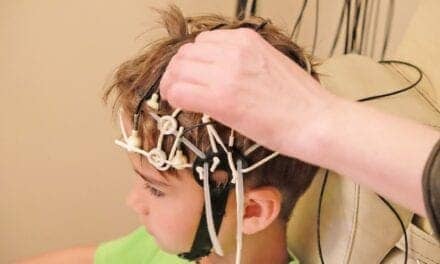Designed by Stephen Sheldon, DO, FAAP, the four-sided model displays normal and obstructed breathing functions for an infant up to 12 months on one side and children ages 3 to 12 years of age on the other.
The National Sleep Foundation (NSF) added a pediatric model to its Sleep Disordered Breathing Anatomical Models in January 2015. The 3D Sleep Disordered Breathing Pediatric Anatomical Model enables primary care physicians, sleep specialists, and pediatricians to more easily show patients and parents the anatomical differences between normal and obstructed breathing functions.
“Model” Inspiration
The designer of the Sleep Disordered Breathing Pediatric Anatomical Model is Stephen Sheldon, DO, FAAP, professor of pediatrics and neurology at Northwestern University Feinberg School of Medicine and director of the Sleep Medicine Center at Ann and Robert H. Lurie Children’s Hospital of Chicago. Sheldon is on the board of directors of the NSF and is also the chair of the education committee, so he says the development of the model was a natural outgrowth of clinical practice and education.
Educating parents and young patients was the primary inspiration for the development of the new model. As the causes of sleep-disordered breathing (SDB) in children, or pediatric obstructive sleep apnea (OSA) and adult SDB or adult OSA vary greatly, Sheldon says describing the potential causes in children can be significantly facilitated using a model. Prior to the creation of this new model, in his personal practice, Sheldon explains pictures would be drawn to illustrate the disorder to the parent and child, but the 2D pictures caused difficulty when discussing the condition. “No matter how good the art, these pictures were not completely accurate in scale and proportion, [which made] it more difficult to discuss the causes and approach to management to parents and children.”
As such, the model was created as an educational tool and a model for parents and kids to understand the causes and treatment of OSA. “The NSF adult model is an excellent resource for the practitioner, but did not include that which is specific for children,” says Sheldon. “Therefore, a pediatric model appeared to be needed to best explain the causes and treatment of pediatric OSA to children and their families. The model provides a focal point for diagnosis and management of pediatric OSA in both infants and older children.”
Features and Benefits
The 3D Sleep Disordered Breathing Pediatric Anatomical Model has a variety of features and benefits for sleep medicine professionals and their patients. According to Sheldon, a model specific to children was a necessary sleep education tool due to the difference in anatomy between an adult and child as well as the varying causes of SDB in children. “Children are not just small adults. Therefore, anatomy cannot just be made smaller, since it is clearly different. This demands a different model since the adult model cannot address issues that are uniquely related to infants and children,” says Sheldon.
Also, the causes for SDB are significantly different from adults, making a model designed specifically for children the primary benefit of this new product. In addition, Sheldon says the causes for SDB are different from infants and older children, which led Sheldon to create the four-sided model. The four-sided model displays normal and obstructed breathing functions for an infant up to 12 months on one side and children ages 3 to 12 years of age on the other.
The portable model also includes a base stand and a double-sided educational backdrop card, showing a detailed, full-color labeled image of the anatomy. The education cards are similar to the adult model but focus on the differences between etiology and treatment in children and adults. Additionally, the model features a moveable transparency flap showing adenoids and tonsil attached to each obstructed side of the infant and child heads, as well as acetate overlays that show pathology and what happens with treatment.
“It is a superior aid in explaining the causes of pediatric sleep apnea to parents and children. Additionally, the pathology overlays provide a mechanism to discuss various treatment approaches in a ‘before and after’ manner,” says Sheldon.
A New Tool for Sleep
The Sleep Disordered Breathing Pediatric Anatomical Model from the NSF may be a valuable aid for sleep medicine professionals to help educate young patients. With a variety of unique features, the 3D model may help parents and children better understand the causes and treatment of pediatric OSA.
“It’s important for young patients and their families to understand how obstructed breathing impacts their overall sleep health. This model helps healthcare professionals to demonstrate simply and clearly what is happening,” Sheldon says. “It is hoped it will be useful for sleep medicine specialists, primary care specialists, ENT specialists, and all child health care practitioners to assist in education of patients and parents into the causes and treatment of obstructive sleep apnea in infants and children.”
Cassandra Perez is associate editor of Sleep Review. CONTACT [email protected]





Finally, a useful teaching aid for “all child healthcare practioners” who screen for/treat pediatric SDB/OSA (e.g., pediatric dentists, orthodontists, general dentists, myofunctional therapists, et al)! Way to go Dr. Sheldon.
I just ordered 2 .. Thanks Dr Sheldon